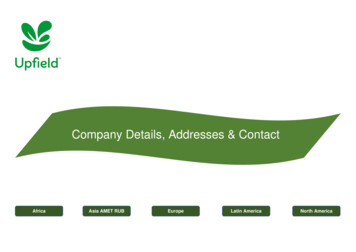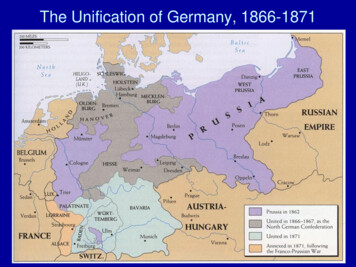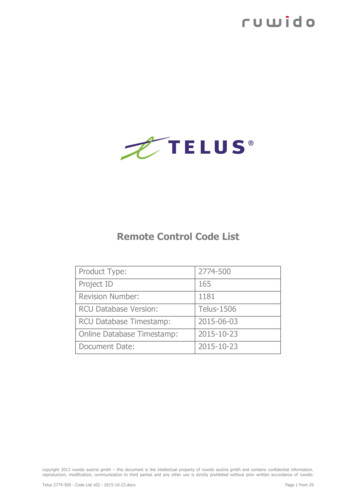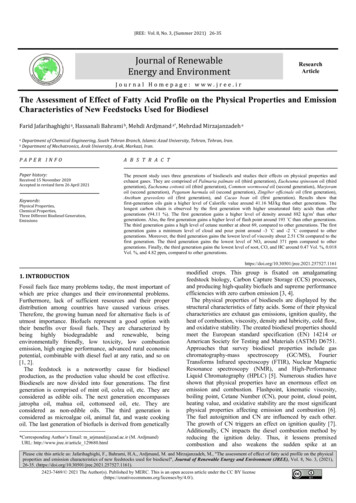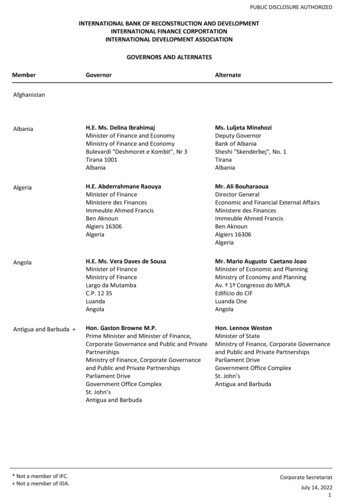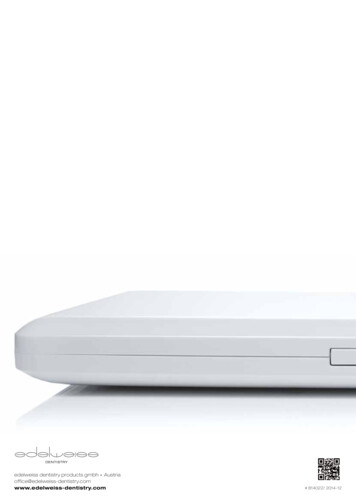
Transcription
edelweiss dentistry products gmbh · -dentistry.com# 814022/ 2014-12
DIRECT SYSTEM
Bio-Estheticsand function inone appointmentedelweiss dentistry is a dental „think tank“ thatconceptualizes and produces innovative systematicsolutions that are developed together with partnerswithin the dental industry and marketed exclusivelyvia the dental distribution network. The alliancebetween inspiration and technical know-how is focus.VENEER & OCCLUSIONVD from edelweiss are stateof the art for modern and minimally invasive estheticdentistry. For the first time in the history of dental, itis now possible to work with prefabricated veneersmade from Nano-Hybrid composite using modernlaser technology. Never before has it been feasibleto directly create the natural shape and youthfulluminance of a tooth, so easily and perfectly in onlyone appointment. Its versatile area of applicationtogether with its time and cost saving proceduremake edelweiss VENEER & OCCLUSIONVD a soundinvestment in the future with the best interest of thepatient in mind. Convince yourself.Stephan LamplCEO, Founder & Inventor ofedelweiss dentistryClaudio NovelliClinical andScientific Director
DIRECT SYSTEMIndexPageIntroduction2The Composition VENEER4 - 7Case Documentations VENEER8 - 13- Ceramic Crown Facing11- Periodontal Veneer Case12The Progressive Technical Concept VENEER14The Technical Aspects VENEER15Technical Data16Sizes VENEER17Natural Layering Technique18Shades19Step by Step VENEER20 - 21Innovation OCCLUSIONVD22 - 23The Composition OCCLUSIONVD24 - 25The Progressive Technical ConceptOCCLUSIONVD26 - 27The Technical Aspects& Sizes OCCLUSIONVD28 - 29The Vertical Dimension OCCLUSIONVD30 - 35Step by Step OCCLUSIONVD & VENEER36 - 45Full Mouth RehabilitationOCCLUSIONVD & VENEER46 - 49Metal Ceramic Crown Repair OCCLUSIONVD50 - 51Toolboxes52 - 53Refills54 - 553
TheComposition
DIRECT SYSTEMVENEEROCCLUSIOCOMPOSIT5
YESTERDAYTODAY1Non-prep preoperativesituation with retraction cord.(00 ultrapak)2 Etching with UPI Ultra-Etch1233 Applying UPI Peak UniversalBond4 Adjusted & filled VENEER5 Application of VENEER456 Position & press the VENEER6into place7 Tack curing near the incisal edgewith VALO, UPI8 Cemented VENEER7ADVANTAGESOne appointmentMinimally invasiveNatural erialEconomical899 Finishing of incisal edges
DIRECT SYSTEMVENEEROCCLUSIOCOMPOSITINDICATIONSAnterior and posterior restorationsTooth discolorationsAnatomical deformitiesDiastemaErosion & AttritionCustomized Veneers, Crowns & BridgesCrown facingsLifting the vertical dimension (CMD)7
YESTERDAYTODAY
DIRECT SYSTEMVENEEROCCLUSIOCOMPOSIT9
YESTERDAYTODAY
CeramicCrown Facing1247356891Preoperative situation2 Isolation with ultradent Opal Damand etching with ultradentCeramic Etch107 Application of VENEER8 Finish interproximal areasusing finish Soflex Discs9 Application of VENEER3 Etching with UPI Ultra-Etch10 Position & press the VENEER4 Applying UPI Peak Universalinto placeBond11 Final postoperative situation5 Light curing with VALO (UPI)116 Covering metal area withedelweiss Opaque White11
PeriodontalVeneer CaseBEFOREAFTERIncorporating facial placed fibres incombination with edelweiss VENEERsprovides stability and natural esthetics.
DIRECT SYSTEMVENEEROCCLUSIOCOMPOSIT13
TheProgressiveTechnicalConceptedelweiss VENEERThe laser-treated process combines the bestof two worlds: a homogenous, inorganic andhigh-gloss surface fused together with athermally-tempered and dynamic compositecore produce optimal integration betweenfunction and esthetics. The difference is inits similarity to nature.CERVICAL AREA:0.2 mmFACIAL AREA:0.6 mmINCISAL EDGE:1.0 - 1.3 mmdistinct layer of vitrified glasssmooth inorganic surfacewithout visible composite structurelaser sintered bodyhigh composite density
TheTechnicalAspectsDentin/EnamelBond(Peak Univ.,Optibond)EnamelVENEER teedelweiss VENEERView of a sectioned extracted human molar with a cemented prefabricated compositeVENEER bonded to half of the enamel surface and the other half to the dentin surface.Study available at www.edelweiss-dentistry.comFatigue behavior for composite edelweiss VENEERs:A recent in vitro study demonstrated that prefabricated composite edelweissVENEERs cemented onto the enamel and dentin surface of molars, effectivelyresisted simulated functional fatigue and load testing. Virtually no defects wereobserved at both the enamel and dentin margins, either before or after loading,which typically represents the most vulnerable area of a restoration.The most relevant observation made was obtained uponthe evaluation of the inner adaptation of the restoration.No defects were visible at the interface of the enamel orin between the restorative composite and the edelweissVENEER, which confirmed the excellent bonding strengthand stability at both interfaces (dentin/enamel to composite, composite to edelweiss VENEER).VENEERUniversitéde GenèveCompositeEnamelDentinProf. Dr. Didier DietschiD.M.D, PhD, Privat-DocentSpecialist SVPRAssociate. Professor15
TechnicalDataNANO PARTICLESILICIA GEL(500 nm)(500 nm)The Nano Hybrid Composite:Fillers with particle sizes in the nano meter range („nanoparticles“) show a strong tendency of aggregationand agglomeration. Therefore they do not reach theirfull potential for improvements of the properties ofthe composite (e.g. shrinkage, modulus, mechanicalstrength). These aggregated and agglomerated nanoparticles are known for a long time and are used indental materials (Impression materials, composites) formany years. The challenge is to provide these particlesin separated morphology. With the technology used inedelweiss Composites the particles can be separatedto a great extend. This is shown in the left picture.Here the nano particles can reach their full potential forimprovements of shrinkage, modulus and mechanicalstrength.Mechanical properties & benefits: Low shrinkage due to nano-technology and high amount of filler 82 % Good abrasion resistance Very good physical and mechanical properties Antibacterial surface due to zinc and fluoride particles in the filler Easy polishing Natural fluorescence and opalescence(Source: internal data from edelweiss dentistry)COMPOSITEFLOWABLEVENEERFlexural Strength150 MPa120 MPa200 MPaCompressive Strength480 MPa350 MPa550 MPa12.5 (dentin) - 16 GPa (enamel)6 GPa19 GPaSurface Hardness80 HV68 HV95 HVPolymerization Shrinkage2.50 %N.A.—Flexural Modulus
Sizes2UPPER SIZESUpper Jaw (XS, S, M, L)REF 13501 / 2013-4L upSizing GuideREF 13502 / 2014-12Lower Jaw (S, M)Sizing GuideREF 13503 / 2013-4M lowXS upSizing GuideM upS upLOWER SIZESS low4VENEER SIZES Based on a study of allshapes and size variations of natural toothanatomy, prefabricated and contourableuniversal VENEER shapes for the upper andlower arch were developed in the followingrange of sizes:- 20 lower S/M, 10 each- 30 upper S/M/L 10 each- 6 upper XSTHE SELECTION of the tooth shape isperformed with the available Sizing Guide.(edelweiss VENEER Sizing Guide). The SizingGuide is positioned over the teeth to berestored, in which the visible profile allows forproper selection of the best fitting edelweissVENEER. Adjustments can be illustrateddirectly on the template.17
NaturalLayeringTechniqueThe concept was proposed in 1995 by Prof. Dr. D. Dietschiand was published for the first time in 1997. It is based onthe idea of creating a synthesis between light, materialand color in order to mimic the natural tooth structure.edelweiss COMPOSITE restructures teeth using twotoothlike masses that are comparable to dentin andenamel to create restorations with natural looking results.DENTINSHADEThe optical characteristics of natural dentin and enamelwere measured separately. The resulting color codesserved as a reference towards the development of theedelweiss COMPOSITE. One shade system that coversthe complete range of possible tooth colors.51DENTINSingle opacity - same hue, but different chromalevels - fluorescence. From Dentin A0, for therestoration of bleached teeth to Dentin A3.5, forcervical restorations of darker teeth for elderlypatients.Dentin Body shades exhibit high opacity andfluorescence which correspond to natural shadesof dentin.ENAMELVENEER &OCCLUSIONVDENAMELEnamel shade intensifies the translucency,which increase the trueopalescence for all optical variations found innatural dentition.Basic Tint:Enamel3EFFECT SHADESEffect Blue serves to enhanceblue-opalescent effects of theincisal edge. Effect Ice helps tosimulatewidespreadenamelopacities. Opaque White is mainlyused in combination with othershades to produce “opaquers” ofa desired shade to cover eitherseverely discolored tissues ormetals.Tint:Effect Blue, Effect Ice,Opaque WhiteDentin A0Dentin A1Dentin A2Dentin A3Dentin A3.5EnamelEffect BlueEffect IceOpaqueWhite
ShadesDIRECT SYSTEM COLOR RANGEedelweiss-shade / vita-shadeedelweiss SHADE SYSTEMENAMELShade of edelweissVENEER & OCCLUSIONVDENAMEL VENEER & OCCLUSIONVD DENTIN / ENAMELedelweiss VENEERs & OCCLUSIONVD consist of theshade Enamel - Vita Enamel AO. The respective dentin andenamel shades used to cement the edelweiss VENEER &OCCLUSIONVD will determine the final shade tone of therestoration.Example: edelweiss VENEER (Vita Enamel Shade AO)cemented with Dentin Shade A3 (Vita Dentin Shade A3) willresult in the Vita Dentin Shade A3.DentinVITAVENEER& OVD Dentin A0A0VENEER& OVD Dentin A1A1VENEER& OVD Dentin A2A2VENEER& OVD Dentin A3A3VENEER& OVD Dentin A3.5A3.5VENEER& OVD EnamelEnamelF OR B R I G H TN E SS & M A X I M U M B LE N D I N G I N O FN ATU R A L TOOTH COLOR A N D LU M I N A N C E19
1238Placing the Enamel VENEER shell over thedentin core. (for light refraction place glycerinewithin enamel shell first)9REF 13501 / 2013-4S upSizing GuideupStep by StepSelect size for VENEER using edelweissSizing Guide. (single or combined VENEER Sizes)Select the dentin shade at cervical areawith Shade Guide.710 sec20 secTrial fit visualization of edelweiss VENEERs.(facial view)Apply Ultra-Etch (UPI) for 20 sec., then rinseand slightly dry, leaving surface slightlydamp.1314Place a puddle coat of Peak Univ. Bond (UPI)on tooth and gently agigate for 10 sec. Blowair using half pressure to thin and remove solvents.Surface will appear shiny.1520 secClean finger with isopropyl alcohol wipes.Optional: Characterization using edelweissComposite Flow or Effect Shades. (Mamelon,dark cervical) Light cure for 20 sec.1920Dispense 1 cm strip of Nano-HybridComposite onto finger tip.Position and cement edelweiss VENEER intoplace. TIP: Reduce surgical light.Remove excess edelweiss Nano-HybridComposite.Contour excess edelweiss Nano-HybridComposite.25Finish interproximal margins using finefinishing diamond. (40 μm / 8 μm)2126Finish interproximal areas using finishingStrips or Soflex Discs.27Polish interproximal areas usinginterproximal polishing Strips or SoflexDiscs.
DIRECT SYSTEM4Sharpen the marginal edges and rougheninner surface of the edelweiss VENEER.5Adapt the fit and shape along the gingivalmargin.1010 sec11With VALO (UPI) cure for 10 sec. at standardpower. With other Light cure for 20 sec.171823Adapt N.-H. Composite into edelweissVENEER. (Optional: characterize using flowableEnamel composite or Effect Shades,24translucent on incisal area).Place and press Nano-Hybrid Compositeinto concave surface of VENEER.221210 secApply DIRECT VENEER Bond onto innersurface of edelweiss VENEER - 30 sec.16Shape Nano-Hybrid Composite into a small,round ball.6Minimally invasive tooth preparation.30 secWith VALO (UPI) cure for 10 sec. at standardpower. With other Light cure for 20 sec.VENEEROCCLUSIOCOMPOSIT40 secFinish cervical margins using fine finishingAfter positioning light cure with VALO (UPI)diamonds. (40 μm / 8 μm)palatal and facial side of edelweiss VENEERfor 40 sec.2829Polish cervical areas using silicone rubberpolishers (moistened).Finish incisal edges using fine finishingdiamonds. (40 μm / 8 μm)Final postoperative situation.21
Bio-Esthethic& Function
DIRECT SYSTEMINNOVATIONThanks to their unique laser-sintering manufacturingprocess, the translucent enamel and occlusion shells(edelweiss VENEER & OCCLUSIONVD) stand outfor their inorganic, ceramic-like surface vitrificationand tempered composite body. The occlusionsrepresent the anatomic foundations for single orcomplete reconstructions and for increasing thevertical dimension (OVD) in the posterior region.Hence, a functioning anterior cuspid guidance canalso be obtained using edelweiss “VENEERs”.23
TheComposition
DIRECT SYSTEMPatient did not accept rubber dam placementStep by Step description on page 36 / 37147ADVANTAGESMinimally invasiveClinically effectiveNatural lookLong erior and posterior restorationsTooth discolorationsAnatomical deformitiesErosionAttritionLifting the vertical dimension (CMD)Semi- direct and indirect restorationsCrown Facings25
TheProgressiveTechnicalConceptedelweiss VENEER & OCCLUSIONVDThe laser-treated process combines the best of twoworlds: a homogenous, inorganic and high-glosssurface fused together with a thermally-tempered anddynamic composite core produce optimal integrationbetween function and esthetics. The difference is in itssimilarity to nature.smooth inorganic surfacewithout visible composite structure
DIRECT SYSTEMMARGINAL AREA:0.2 mmOCCLUSION AREA:0.6 - 1.3 mmOCCLUSIONVDdistinct layer of vitrified glassscale: 10 000 xFlexural Strength200 MPaCompressive Strength550 MPaFlexural Modulus19 GPaSurface Hardness95 HV(Source: University of Geneva / internal data edelweiss dentistry)27
TheTechnicalAspects& SizesMAXILLASHAPES & SIZESBased on a study of all shape and size variations of naturaltooth anatomy, prefabricated and contourable universalocclusion shapes for the upper and lower arches weredeveloped.THE SELECTION of the tooth shape is made using theavailable sizing guide (OCCLUSIONVD - Sizing Guide). Thesizing guide is positioned over the teeth to be restored,and the outline allows for proper selection of the bestfitting occlusion.MORPHOLOGY Ultra-thin, anatomical occlusionsin three sizes (S, M & L). The glass component in thecomposite filler and laser treatment of the surfacegive the material nature-like mechanical properties(biomechanics), and the material is also biocompatible(biology). Due to the natural morphology, the prefabricatededelweiss OCCLUSIONVDs are very easy to incorporateinto an existing occlusion.
DIRECT SYSTEMMANDIBULA34s2441254435545136Sizing Guide266164REF 13505 / 2013-3372771Upper3424M41254435545136Sizing Guide266174Lower64REF 13506 / 2013-33727Upper713424L412551266144355436Sizing Guide64REF 13507 / 2013-337277174LowerUpperLower7429
TheVerticalDimension
DIRECT SYSTEMFUNCTIONedelweiss VENEERs & OCCLUSIONVD allow forminimally invasive biomechanical and economicaltreatment of the cause as well as prevention of cranio-mandibular dysfunction (CMD). Furthermore,malocclusion and deep bites can also be corrected minimally invasively. By covering the occlusalsurfaces, usually in the mandible, the mandible isbrought into the correct position for the patientin relation to the maxilla. This makes it possible toattain functioning guidance of anterior teeth andcuspids by using edelweiss VENEERs.LIFTING THE VERTICAL DIMENSION.using edelweiss occlusal surfaces. In most casesthe mandible is appropriate. It can often beidentified by the great difference in height fromthe cuspid to the premolar (33 to 34 and 43 to 44).However, to ensure that lifting, and protrusionif necessary, is equal on the left and right, thisneeds to be tested using situation models on thearticulator. In the premolar region this can meancapping up to 5 mm, and up to a further 3 mm inthe molar region.31
TheVerticalDimension
DIRECT SYSTEMPROCEDUREThe maxilla and the mandible models are articulated head-adequate in habitual intercuspation.Protrusion is then performed as required and thesupporting pin of the articulator raised. Michigan orPartial bite splints with “stops” are prepared for themandibular quadrants. These are fixed temporarilyin the mouth, in other words, provisionally. Aftera few weeks this will already represent the idealposition of the mandible, possibly requiringre-occlusion. On the basis of these bite splints themandible is articulated anew against the maxilla.INDIRECT APPLICATIONBy relining the prefabricated occlusal surfaces onexisting model occlusal surfaces with composite,one can simply create a new functioning biomechanical, balanced and smoothly workingmasticular apparatus without irritations. Then theocclusions are transferred from the model to thepatient’s occlusions and attached via bonding andcomposite.33
TheVerticalDimension
DIRECT SYSTEMDIRECT PROCEDURE for advanced professionals:Instead of lining the occlusions on the model in thearticulator, a bite registration material (silicone) is usedto make an occlusal impression which accuratelyportrays the clearance between the maxilla and themandible in the articulator. Using the fixed siliconebite register, direct application of the prefabricatedocclusion can be performed. The silicone biteregister is in each case placed unilaterally (left orright) on the patient’s occlusion. In other words,when the left quadrant is restored with occlusions,the right quadrant sets the height and position ofthe bite elevation and thus the final position of thecomposite-lined and bonded occlusions on the leftwhen biting down (replacing the supporting pin whenclosing the articulator).Once the left quadrant has been restored, the rightquadrant is treated. Now one can optionally preparea further silicone register from the quadrant alreadyrestored with occlusions (left) in combination withthe silicone register (right) already prepared with thearticulator, which additionally guides and sets thealready attained occlusional relationship betweenthe maxilla and the mandible (left) during biting.Practised users can dispense with this siliconeregister (for example, on the left) as the patient nowalready bites on the newly gained occlusion or biteelevation during biting. After setting all occlusions,re-occlusion is performed until the desired contactpoints have been attained.35
Step by StepPatient did not accept rubber dam placement1Relined and customized OCCLUSIONVD bydental technician.2Application of VENEER Bond ontoOCCLUSIONVD.73Gently air dry inner surface.8920 secLight cure for 20 sec. with VALO (UPI) atApplication of N.-H. Dentin or Enamelstandard power. With other Light cure for 40 sec. Composite.13Adaptation of N.-H. Dentin/EnamelComposite.141520 secInsertion of the OCCLUSIONVD.Positioning of OCCLUSIONVD and removal of Floss interproximal areas then light cure for20 sec. with VALO (UPI) at standard power.surplus material. Adapt margins.With other Light cure for 40 sec.
DIRECT SYSTEM45630 sec20 secLight cure for 20 sec. with VALO (UPI) atEtching for 30 sec.standard power. With other Light cure for 40 sec.10Bonding (UPI, peak universal) / Flossinterproximal areas before light curing withVALO (UPI).111220 secPositioning and removal of surplus material. Floss interproximal areas then light cure for Finishing of interproximal area.20 sec. with VALO (UPI) at standard power.With other Light cure for 40 sec.16Finish and polish margins using finefinishing diamonds and Jiffy polishers.1817Relaxed bite position in verticaldimension.Front view / space for lower VENEERs.37
Step by StepPatient did not accept rubber dam placement1Shade Guide.2Select the dentin shade at cervical areawith dentin Shade Guide.7Placing the enamel VENEER shell overthe dentin core (for light refraction placeglycerine within enamel shell first).20 secPull Mylar Strips facially to achieve smoothmargins and cure through Mylar Strips for3 sec. (VALO UPI). With other Light cure for 6 sec.13Polish VENEER margins using siliconerubber polisher.Light cure lingual and facial side of tooth for20 sec. each (VALO UPI). With other Light curefor 40 sec.1514Visual observation.Visual observation.2019Trial fit visualization of edelweiss VENEERs.9983 secPlace Mylar Strips both mesial and distal ofall teeth to be treated.3Prepare tooth using minimally invasivetechniques.21Fit and adapt the edelweiss VENEER usingthe gingival margin as your guide.
DIRECT SYSTEMVENEEROCCLUSIOCOMPOSIT45620 secSelect edelweiss VENEER size usingedelweiss Sizing Guide (single or combinedVENEER Sizes may be used).Apply Ultra-Etch for 20 sec., then rinse andslightly dry, leaving surface slightly damp.10Finish cervical and interproximal marginsusing fine finishing diamonds.Reocclusion.12Finish interdental areas using Soflex Discs.1817Finish interproximal margins using a finefinishing diamond.22Sharpen the marginal edges and rougheninner surface of the edelweiss VENEER.11Finish incisal edge using fine finishingdiamonds.16First anterior VENEER in position.Proof of functional movements.23Sharpen the marginal edges and rougheninner surface of the edelweiss VENEER.24Trial fit visualization of edelweiss VENEERs.39
Step by Step252620 secInsert retraction cord. (00 ultrapak)2710 secPlace a puddle coat of Peak Universal BondPlace Mylar Strips both mesial and distal(UPI) on tooth and gently agigate for 10 sec.of all teeth to be treated. Apply Ultra-Etch(UPI) for 20 sec., then rinse and slightly dry,leaving surface damp.33313220 secLight cure for 20 sec. with VALO (UPI) atstandard power. With other Light cure for 40 sec.Gently air dry.37Dispense strip of edelweiss N.-H.Compositeonto inner surface of the VENEER.38393 secRemove excess edelweiss N.-H. Compositefrom incisal edge.Tack cure with VALO (UPI) near the incisaledge for 3 sec. using a Point cure lens tostabilize VENEER.444320 secLight cure with VALO (UPI) lingual and facialside of tooth for 20 sec each. With other Lightcure for 40 sec.Remove excess edelweiss N.-H. Compositefrom the rest of the margins.4510 secCemented VENEER.Place a puddle coat of Peak Universal Bond(UPI) on tooth and gently agigate for 10 sec.
DIRECT SYSTEMVENEEROCCLUSIOCOMPOSIT28293010 secBlow air using half pressure to thin andremove solvents. Surface will appear shiny.With VALO (UPI) cure for 10 sec. at standardpower. With other light cure for 20 sec.Place a puddle coat of VENEER Bond onedelweiss VENEER and gently agitate for10 sec. Blow air using half pressure to thinand remove solvents.363534Adapt N.-H. Composite into edelweissVENEER. (Optional: characterize using flowableEnamel Composite or Effect Shades, for highertranslucent on incisal area).VENEER ready for placement.Position and press the edelweiss VENEERinto place (Tip: reduce operatory light).414042sec33secPull Mylar Strips facially to achieve smoothmargins.Cure through Mylar Strips for 3 sec. (VALOUPI). With other Light cure for 6 sec.4647Bend Mylar Strip over interdental area.4810 secBlow air using half pressure to thin andremove solvents. Surface will appear shiny.With VALO (UPI) cure for 10 sec. at standardpower. With other light cure for 20 sec.Position and press the edelweiss VENEERinto place (Tip: Reduce operatory light).41
Step by Step49505120 secAfter positioning light cure with VALO (UPI)palatal and facial side of edelweiss VENEERfor 20 sec. each.Finish cervical and proximal margins usingfine finishing diamonds.55Visual observation.BEFORE56Polish VENEER margings using Jiffy siliconerubber polishers.AFTERRemoval of retraction cords.57For high shine polish VENEER margins withJiffy polishers (UPI).
DIRECT SYSTEMVENEEROCCLUSIOCOMPOSIT52Finishing of incisal edges.53Finish interproximal areas using finishingSoflex Discs.54Reocclusion.58Visual observation.BEFOREAFTER43
YESTERDAYTODAYTENSED SMILE BEFORE
DIRECT SYSTEMVENEEROCCLUSIOCOMPOSITRELAXED SMILE AFTER45
Full MouthRehabilitation
DIRECT SYSTEMVENEEROCCLUSIOCOMPOSIT47
YESTERDAYTODAY
DIRECT SYSTEMVENEEROCCLUSIOCOMPOSIT49
Metal CeramicCrown RepairAFTER ENDODONTIC TREATMENT1Preoperative situation.2Prepared and roughened crown.73Trial fit of OCCLUSIONVD on preparedcrown.8920 secLight Cure for 20 sec with VALO (UPI) atstandard power. With other Light cure for 40 sec.Cover metal area with edelweiss OpaqueWhite Effect Shade.13Dispense edelweiss N.-H. Composite ontoinner surface of the OCCLUSIONVD.14152040 secFloss interdental area.19Proof of functional movements.Visual observation.Light cure with VALO (UPI) for 20 sec. oneach side of crown. With other Light cure for40 sec.20Side view.21Occlusal view.
DIRECT SYSTEM4Trial fit of OCCLUSIONVD on preparedcrown.1011Position and press OCCLUSIONVD in place.16Reocclude.Placing a puddle coat of Peak Univ. Bond(UPI) on crown & inserting dental floss forseparation.Isolation with ultradent Opal Dam andetching with ultradent ceramic etch.Adapt edelweiss N.-H. Composite intoOCCLUSIONVD.6512Adapt edelweiss N.-H. Composite & removeexcess.17Visual observation after reocclusion.18Finish cervical and interproximalmargins using Soflex Discs.51
ToolboxesADVANCEDDIRECT SYSTEM VENEER & OCCLUSIONVD TOOLBOXREF 1370036edelweiss VENEERs1VENEER SET S up (1 x 14, 13, 12, 11, 21, 22, 23, 24 S)1VENEER SET M up (1 x 14, 13, 12, 11, 21, 22, 23, 24 M)1VENEER SET L up (1 x 14, 13, 12, 11, 21, 22, 23, 24 L)1VENEER SET S low (1 x 43, 42, 41, 31, 32, 33 S)1VENEER SET M low (1 x 43, 42, 41, 31, 32, 33 M)48edelweiss OCCLUSIONVD2OCCLUSIONVD SET S up (1 x 17, 16, 15, 14 S) (1 x 24, 25, 26, 27 S)2OCCLUSIONVD SET M up (1 x 17, 16, 15, 14 M) (1 x 24, 25, 26, 27 M)2OCCLUSIONVD SET L up (1 x 17, 16, 15, 14 L) (1 x 24, 25, 26, 27 L)2OCCLUSIONVD SET S low (1 x 47, 46, 45, 44 S) (1 x 34, 35, 36, 37 S)2OCCLUSIONVD SET M low (1 x 47, 46, 45, 44 M) (1 x 34, 35, 36, 37 M)2OCCLUSIONVD SET L low (1 x 47, 46, 45, 44 L) (1 x 34, 35, 36, 37 L)25edelweiss NANO-HYBRID COMPOSITEDENTIN SHADE5Dentin A0 0.3 g Tip5Dentin A1 0.3 g Tip5Dentin A2 0.3 g Tip5Dentin A3 0.3 g Tip5Dentin A3.5 0.3 g Tip5edelweiss NANO-HYBRID COMPOSITEENAMEL SHADE5Enamel 0.3 g Tip1edelweiss NANO-HYBRID COMPOSITE FLOW1Enamel Flowable 1.5 g Syringe2edelweiss EFFECT SHADES1Opaque White 1.5 g Syringe1Effect Blue 1.5 g Syringe1edelweiss BOND1VENEER Bond 5 ml BottleACCESSORIESDentin & Enamel Shade GuideVENEER & OCCLUSIONVD Sizing Guide up & lowFLOW Application Tips (10x)Removable cover for more flexibilityStep by Step BookletInstructions for use
DIRECT SYSTEMSTARTERDIRECT SYSTEM VENEER TOOLBOXREF 13710STARTERDIRECT SYSTEM OCCLUSIONVD TOOLBOXREF 1372020edelweiss VENEERs321VENEER SET S up(1 x 13, 12, 11, 21, 22, 23 S)2OCCLUSIONVD SET S up(1 x 17, 16, 15, 14 S) ( 24, 25, 26, 27 S)1VENEER SET M up(1 x 14, 13, 12, 11, 21, 22, 23, 24 M)2OCCLUSIONVD SET M up(1 x 17, 16, 15, 14 M) (1 x 24, 25, 26, 27 M)1VENEER SET L up(1 x 13, 12, 11, 21, 22, 23 L)2OCCLUSIONVD SET S low(1 x 47, 46, 45, 44 S) (1 x 34, 35, 36, 37 S)2OCCLUSIONVD SET M low(1 x 47, 46, 45, 44 M) (1 x 34, 35, 36, 37 M)25edelweiss NANO-HYBRID COMPOSITEDENTIN SHADE5Dentin A0 0.3 g Tip5Dentin A1 0.3 g Tip5Dentin A2 0.3 g Tip5Dentin A3 0.3 g Tip5Dentin A3.5 0.3 g Tip5edelweiss NANO-HYBRID COMPOSITEENAMEL SHADE5Enamel 0.3 g Tip1edelweiss NANO-HYBRID COMPOSITEFLOW1Enamel Flowable 1.5 g Syringe2edelweiss EFFECT SHADES1Opaque White 1.5 g Syringe1Effect Blue 1.5 g Syringe1edelweiss BOND1VENEER Bond 5 ml Bottle25edelweiss OCCLUSIONVDedelweiss NANO-HYBRID COMPOSITEDENTIN SHADE5Dentin A0 0.3 g Tip5Dentin A1 0.3 g Tip5Dentin A2 0.3 g Tip5Dentin A3 0.3 g Tip5Dentin A3.5 0.3 g Tip5edelweiss NANO-HYBRID COMPOSITEENAMEL SHADE5Enamel 0.3 g Tip1edelweiss NANO-HYBRID COMPOSITEFLOW1Enamel Flowable 1.5 g Syringe1edelweiss BOND1VENEER Bond 5 ml BottleACCESSORIESDentin & Enamel Shade GuideACCESSORIESDentin & Enamel Shade GuideVENEER Sizing Guide up & lowFLOW Application Tips (10x)OCCLUSIONVD Sizing Guide up & lowFLOW Application Tips (10x)Step by Step BookletInstructions for useStep by Step BookletInstructions for use53
Refillsedelweiss VENEER SET REFILLSREF 10161edelweiss VENEER 21 LREF 13000edelweiss VENEER SET 14-24 S up(1 x 14, 13, 12, 11, 21, 22, 23, 24 S)REF 14128edelweiss VENEER 22 XSREF 10162edelweiss VENEER 22 SREF 13010edelweiss VENEER SET 14-24 M up(1 x 14, 13, 12, 11, 21, 22, 23, 24 M)REF 10163edelweiss VENEER 22 MREF 13020edelweiss VENEER SET 14-24 L up(1 x 14, 13, 12, 11, 21, 22, 23, 24 L)REF 10164edelweiss VENEER 22 LREF 14129edelweiss VENEER 23 XSREF 10165edelweiss VENEER 23 SREF 10166edelweiss VENEER 23 Medelweiss VENEER 23 LREF 13030edelweiss VENEER SET 44-34 S low(1 x 44, 43, 42, 41, 31, 32, 33, 34 S)REF 13040edelweiss VENEER SET 44-34 M low(1 x 44, 43, 42, 41, 31, 32, 33, 34 M)REF 10167REF 13106edelweiss VENEER 24 SREF 14121edelweiss VENEER SET XS up(1 x 13, 12, 11, 21, 22, 23 XS)REF 13107edelweiss VENEER 24 MREF 13108edelweiss VENEER 24 Ledelweiss VENEER SET S up(1 x 13, 12, 11, 21, 22, 23 S)REF 13109edelweiss VENEER 25 SREF 10110edelweiss VENEER SET M up(1 x 13, 12, 11, 21, 22, 23, M)REF 13110edelweiss VENEER 25 MREF 13111edelweiss VENEER 25 LREF 10120edelweiss VENEER SET L up(1 x 13, 12, 11, 21, 22, 23 L)REF 10168edelweiss VENEER 31 SREF 10169edelweiss VENEER 31 Medelweiss VENEER SET S low(1 x 43, 42, 41, 31, 32, 33 S)REF 10170edelweiss VENEER 32 SREF 10171edelweiss VENEER 32 Medelweiss VENEER SET M low(1 x 43, 42, 41, 31, 32, 33 M)REF 10172edelweiss VENEER 33 SREF 10173edelweiss VENEER 33 MREF 13112edelweiss VENEER 34 SREF 13113edelweiss VENEER 34 MREF 13114edelweiss VENEER 35 SREF 13115edelweiss VENEER 35 MREF 10174edelweiss VENEER 41 SREF 10175edelweiss VENEER 41 MREF 10176edelweiss VENEER 42 SREF 10177edelweiss VENEER 42 MREF 10178edelweiss VENEER 43 SREF 10179edelweiss VENEER 43 MREF 13116edelweiss VENEER 44 SREF 13117edelweiss VENEER 44 MREF 13118edelweiss VENEER 45 SREF 13119edelweiss VENEER 45 MREF 10100REF 10130REF 10140edelweiss VENEER SINGLE REFILLSREF 14122edelweiss VENEER 11/2
cervical restorations of darker teeth for elderly patients. Dentin Body shades exhibit high opacity and fluorescence which correspond to natural shades of dentin. 1 ENAMEL Enamel shade intensi - fies the translucency, which increase the true opalescence for all op - tical variations found in natural dentition. Basic Tint: Enamel 3
